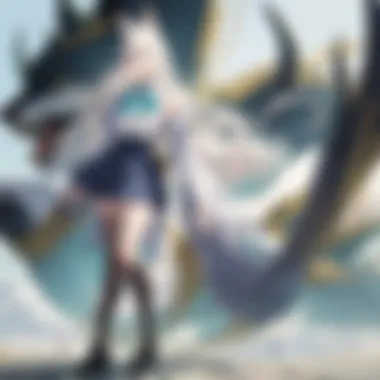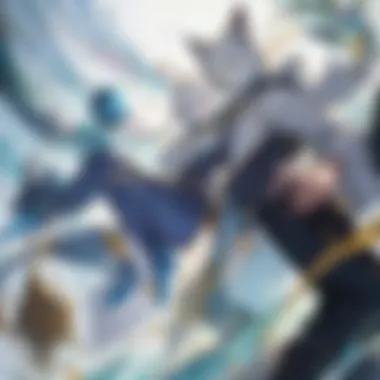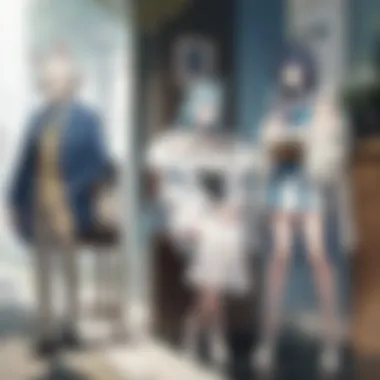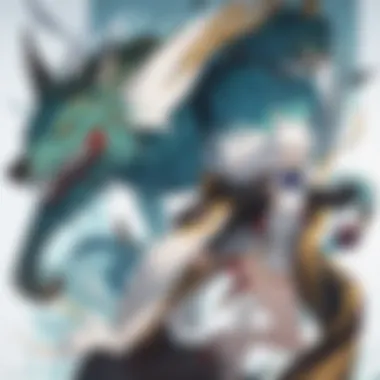Analyzing Beastars: Themes, Characters, and Impact


Intro
Beastars has carved an indelible mark in the manga landscape since its debut. This series intricately explores animal society, focusing on the relationships and conflicts arising from diverse species coexisting. The narrative is more than just a tale of anthropomorphic characters; it delves into profound themes like identity, prejudice, and the complexities of growing up. This exploration aims to dissect these elements and reveal what makes Beastars significant beyond its storytelling.
Featured Series or Manga
Overview of the Series
Beastars, penned by Paru Itagaki, depicts a world where anthropomorphic animals live alongside humans. The story is rooted in a high school environment where the struggles of adolescence are amplified by the animals’ biological instincts. At its core, the tale revolves around Legoshi, a gray wolf grappling with his predatory nature, and Haru, a dwarf rabbit who defies societal norms. This juxtaposition of character species adds layers to the narrative, facilitating a study of social hierarchies and personal identity. With a unique art style, the manga balances lighthearted moments with harrowing themes, capturing the attention of readers worldwide.
Key Characters and Development
Central to Beastars is its emphasis on character development. Readers engage with Legoshi as he navigates his emotions and instincts. His character arc illustrates a gradual journey from uncertainty to self-acceptance. Alongside him, Haru embodies boldness, challenging societal expectations. Other pivotal characters, such as Louis, a red deer, showcase ambition intertwined with vulnerability, enriching the narrative with their individual struggles.
Character Analysis
Major Characters
- Legoshi: The conflicted wolf, representing the struggle between primal instincts and reason.
- Haru: A white rabbit who defies conventions, challenging her role within the food chain.
- Louis: A charismatic and ambitious red deer, emblematic of societal pressures and desires.
Character Arcs and Growth
Character growth is a salient feature of Beastars. Legoshi’s evolution from a timid creature to someone who confronts his fears highlights the theme of self-discovery. Haru’s path from being perceived as a victim to an empowered individual showcases resilience. Louis grapples with the weight of expectation and ambition, providing a narrative thread that addresses leadership's burdens.
Thematic Exploration
Main Themes and Messages
Several themes permeate Beastars. Primarily, the manga addresses identity—how individuals define themselves amid societal expectations. Prejudice and discrimination also play a critical role, emphasizing the divisions between carnivores and herbivores. The series navigates these conflicts with a sensitive lens, portraying how fear can distort perception.
Cultural Context and Influences
Beastars resonates with contemporary societal issues, such as the exploration of sexuality and the complexities of interpersonal relationships. Its cultural impact is significant, making it a vehicle for discussions related to identity, belonging, and acceptance. As readers engage with the series, they navigate the intricacies of the human experience reflected in animals, which transcends its unusual setting.
"Beastars serves as a mirror, reflecting societal constructs and challenging readers to rethink biases and relationships."
Preamble to Beastars


The Beastars manga represents a significant cultural artifact in modern storytelling, intertwining themes of identity, societal structure, and the intricacies of personal relationships. Understanding its introduction and the context in which it was created is essential for grasping its depth and the ongoing discourse around it. This section explores the origins of Beastars, along with its genre and stylistic elements, shedding light on why it resonates with readers across the globe.
Origins and Publication History
Beastars, written and illustrated by Paru Itagaki, first began serialization in Weekly Young Jump in September 2016. Its roots are deeply embedded in the author's personal experiences and observations of society, particularly the cultural nuances of Japan. From its inception, Beastars distinguished itself from the vast spectrum of manga by fusing anthropomorphic characters with realistic depictions of societal issues.
The manga's rise can be attributed to unique storytelling techniques and relatable themes, quickly attracting a dedicated fan base. The series has enjoyed critical acclaim, winning multiple awards, including the Eisner Award for Best U.S. Edition of International Material in 2020. This recognition confirms its place not only as a compelling narrative but also as a serious artistic endeavor within the manga market.
Genre and Style
Manga is known for its variety of genres, and Beastars defies simple categorization. While often placed within the shounen demographic, its themes engage with drama, romance, and psychological elements. Its narrative style effectively blends humor and tension, producing an emotional rollercoaster that engages readers.
Visually, Itagaki employs a distinctive art style that enhances the storytelling. The character designs underscore the duality of the characters' animalistic traits and their human-like qualities. This stylization not only captures the essence of each character but also adds layers to the narrative's exploration of societal roles and expectations. The contrasts between the characters reveal deeper layers of conflict and desire, rather than merely relying on their animal characteristics.
"In Beastars, animals reflect human vices and virtues, creating a mirror for societal introspection."
Overall, while Beastars sits among contemporaries, its distinctive origins and artistic choices set it apart, making it a seminal work worth delving into in further sections of this article.
Main Characters Overview
The central characters in Beastars are not mere figures in a narrative. They embody the thematic complexity and social commentary that defines this work. Each character is crafted with profound intricacies that reflect real-world issues such as identity, societal pressures, and interpersonal dynamics. Understanding these characters is crucial for grasping the overarching messages of the manga. This section will focus on three pivotal characters: Legoshi, Haru, and Louis. Their journeys intertwine and reveal the layers of the world they inhabit. Through their experiences, readers can appreciate the broader societal implications presented in the story.
Legoshi: The Complex Protagonist
Legoshi serves as the lens through which readers explore the themes of Beastars. As a grey wolf, he grapples with his predatory instincts in a world that demands conformity. His character is a study of contrasts. On one hand, he embodies strength and power typically associated with carnivores. On the other, he is introspective, often questioning his identity and role within society. This duality makes him relatable to audiences who have faced similar dilemmas in their own lives.
Legoshi’s interactions with other characters, particularly Haru and Louis, illuminate his inner struggles. His genuine affection for Haru highlights his desire for connection and acceptance, transcending the predatory boundaries imposed by their society. However, his relationship with Louis, who represents a more aggressive approach to ambition, creates tension and challenges Legoshi's views on strength and vulnerability.
His journey is not only about self-discovery but also about confronting societal expectations that come with being a carnivore. Legoshi is a character that resonates deeply, making him an important focal point in the narrative.
Haru: The Symbol of Vulnerability
Haru, the dwarf rabbit, represents vulnerability within the world of Beastars. Her character evokes empathy and illustrates the challenges faced by those who are marginalized. As a female character in a society where physical strength often dictates status, her struggles and resilience provide depth to the narrative.
Her relationships reveal different facets of vulnerability. With Legoshi, she finds an unexpected strength in their bond, contrasting with the predatory norms of their society. This relationship offers a glimpse into how connection can foster personal growth and acceptance.
Despite her vulnerabilities, Haru is not just a passive character. She actively seeks agency in her life, navigating complex emotional landscapes. Her experiences showcase the importance of self-acceptance and the fight against societal prejudices, resonating with readers who appreciate character development rooted in reality. Haru is symbolic of the pressures many face, making her a crucial character in understanding the thematic frameworks of the manga.
Louis: The Ambitious Antagonist


Louis, a red deer, represents ambition and the darker aspects of societal hierarchies. His character is often viewed as an antagonist, but his motivations are deeply rooted in the desire for power. Unlike Legoshi, who questions the constructs of their society, Louis embraces them to ascend to leadership within the drama club, asserting his dominance over the other characters.
His drive is compelling yet complex. Louis embodies the excessive pursuit of status and respect, often at the cost of his relationships. His struggle between personal ambition and the expectations of others creates a multifaceted character that challenges readers to reflect on ambition's implications in their own lives.
Through Louis, Beastars critiques the social structures that elevate certain individuals while oppressing others. His relationship with Legoshi is particularly thought-provoking, as it juxtaposes vulnerability against ambition, raising the question of what it truly means to be strong in a complex society.
Thematic Elements
The thematic elements present in the Beastars manga are crucial for understanding its depth and cultural significance. From identity struggles to social dynamics, these themes not only enrich the narrative but also resonate with readers on multiple levels. Each theme is intricately woven into character development and plot progression, allowing for an exploration of complex societal issues that mirror real-world situations. This layer of storytelling draws in an audience that seeks more than entertainment; it prompts reflection and discussion about contemporary issues.
Identity and Self-Acceptance
Identity is a recurring theme in Beastars, particularly through the journey of Legoshi. As a gray wolf, he grapples with his predatory instincts and societal expectations. Throughout the series, his internal conflicts highlight the broader struggle of self-acceptance. The manga explores how societal labels can shape personal identity. Legoshi's journey is not merely about coming to terms with being a predator but also extends to understanding his emotions and place among herbivores.
The theme further expands through Haru, who, as a small rabbit, embodies vulnerability and strength. Her character challenges the conventions of beauty and worth, often feeling marginalized because of her species. This contrast between Legoshi and Haru's experiences showcases different facets of identity and the need for self-acceptance in a prejudiced world.
"What makes one truly powerful? Is it strength, or is it understanding one's fragility?"
Prejudice and Societal Dynamics
Prejudice is another significant element that Beastars tackles closely. The manga mirrors societal structures where class and status are defined by species. The herbivores and carnivores exist in a delicate balance, representing the real-life issues of racism, discrimination, and societal division. The interactions and conflicts between characters such as Legoshi and Louis illustrate the internalized prejudices that shape their actions and relationships.
Beastars effectively employs these dynamics to prompt discourse on how prejudice affects identity and self-perception. The varying perspectives of different characters allow readers to understand the complexities of societal interactions. This theme pushes readers to reflect on their assumptions and biases in their lives, prompting a clearer understanding of the implications of discrimination.
Love and Relationships
The exploration of love and relationships in Beastars reveals the intricate connections between the characters and underscores the overarching themes of identity and prejudice. The relationships, whether romantic or platonic, are often complicated by the characters' species, drawing attention to the struggles faced in loving someone perceived as “other.”
Legoshi’s feelings for Haru embody this complexity. Their romance is not just a love story; it is a means to explore deeper themes of acceptance and understanding. The challenges they face expose the societal barriers and inner conflicts that arise from their differing natures. They offer a unique juxtaposition that illustrates how love can both bridge divides and highlight differences.
Artistic Approach and Visual Style
The artistic approach of the Beastars manga is a crucial element in understanding its narrative depth and the emotional weight carried by its characters. This section focuses on how the visual elements work together to enhance storytelling and convey complex themes effectively. The combination of character design, panel layout, and other visual techniques contributes immensely to the viewer's experience.
Character Design and Symbolism
Character design in Beastars serves more than just aesthetic purposes; it embodies symbolic meanings that resonate with the reader. Each character's animal representation typically reflects their personality traits and societal roles. For example, Legoshi, the wolf, symbolizes both predatory instincts and internal conflict. His design—a tall, muscular figure with soft features—evokes a sense of vulnerability coupled with strength. The contrast in his appearance drives home the theme of identity struggle.
Haru, the rabbit, embodies innocence and fragility. Her petite stature, with delicate features, serves to emphasize her vulnerability within the predatory society. This design choice positions her as a target, highlighting the tensions between carnivores and herbivores in the story. The colors used in the characters' designs often reflect their emotional states or roles within the narrative. Louis, the deer, projects a confident, ambitious air through his regal antlers and sharp lines.


The symbolism inherent in these designs deepens the reader's understanding of the characters' motivations and conflicts. In this way, the art is not merely a backdrop but an integral part of the storytelling process.
Panel Layout and Storytelling
The panel layout in Beastars plays a significant role in pacing and storytelling. The arrangement of panels influences how the reader perceives time and action. For instance, wide panels are often utilized during dramatic moments, allowing readers to savor the gravity of a scene. Conversely, tightly arranged panels can depict chaotic action or inner turmoil, enhancing the feeling of urgency.
Transitions between scenes are typically seamless, guiding the reader through various emotional shifts. The manga often employs a mix of diagonally stacked panels to create dynamic movement, while ensuring the flow of events feels natural. These choices foster an engaging reading experience that invites deeper reflection on the narrative.
Moreover, the use of visual motifs throughout the panels reinforces key themes. Shadows and light play a significant role, often contrasting the duality of characters’ lives within the predator-prey paradigm. This visual storytelling is particularly effective in illustrating the internal struggles faced by characters like Legoshi and Haru.
Overall, the artistic approach in Beastars offers a rich and immersive experience that complements its intricate narratives and character development. By examining character design and panel layout closely, we gain insights into the profound themes of identity, societal dynamics, and interpersonal relationships that define the series.
Cultural Context and Reception
The exploration of Beastars extends beyond its narrative and characters; it encapsulates the societal frameworks in which it flourishes. The Cultural Context and Reception are integral aspects of understanding how this manga resonates with its audience. This section will unpack the interplay between the themes of the manga and the cultural landscape that influences and is influenced by it.
Popularity in Japan and International Markets
Beastars gained remarkable popularity in Japan after its debut in 2016. The unique premise, centered on anthropomorphic animals living in a society rife with prejudice, appealed to a broad demographic. It not only captured the attention of manga enthusiasts but also transcended age barriers. The series was serialized in Weekly Young Jump, allowing it to reach a dedicated readership. Its relatable themes of identity and social conflict struck a chord amid Japan's contemporary social issues.
Internationally, Beastars has made significant waves. The translated volumes and streaming adaptations, including the popular Netflix anime, have introduced the series to a global audience. Fans have praised its deep character studies and moral dilemmas, which prompt discussions on animal rights, social constructs, and self-discovery. The growth of the online manga community has amplified its reach, with forums on platforms like Reddit discussing plot points and cultural implications extensively.
Influence on Contemporary Manga
The impact of Beastars on contemporary manga cannot be understated. It has revitalized interest in the anthropomorphic genre, showcasing how storytelling can parallel real-world issues. The richness of its characters and the complexity of its societal structures suggest new avenues for manga creators.
Several titles that followed Beastars have adopted similar themes, blending escapism with poignant commentary on societal wrongs. Additionally, the art style has inspired many artists who seek to emulate the detailed character designs and dynamic layouts present in Beastars.
"Beastars has paved the way for discussions in manga that were previously unexplored, promoting both creativity and critical analysis in storytelling."
Moreover, the series exemplifies how manga can serve as a mirror to society. As creators navigate issues such as discrimination, relationships, and identity crises, they contribute to a broader dialogue about the human condition. By engaging with Beastars, readers are often prompted to reflect on the parallels in their own lives, illustrating the manga's profound cultural significance.
End: The Enduring Legacy of Beastars
Beastars has carved out a significant niche in the manga landscape, leaving behind a legacy that resonates beyond its pages. The narrative intricacies and the moral dilemmas faced by its characters invite readers to reflect on deeper societal issues. This enables a conversation that goes hand in hand with the themes of identity and self-acceptance, prejudice, and love.
One of the key elements of Beastars is the exploration of interspecies relationships, which is not just a plot device but a reflection of societal dynamics. This thematic depth has led to a wider appreciation of the series as a serious work within the genre, rather than just a simple story about anthropomorphic animals. The nuanced portrayal of characters like Legoshi, Haru, and Louis generates discussions about their respective journeys that mirror real-world issues faced by individuals today.
The cultural impact of Beastars is increasingly notable. Its popularity in Japan and overseas suggests that the themes it tackles are universal, appealing to a wide audience that transcends cultural boundaries. The series opens dialogue about acceptance, societal norms, and the myriad forms of love that can exist in a complex world.
"Beastars challenges conventional narratives and depicts the struggle for identity and belonging in an often judgmental society."
This legacy is not just about entertainment; it serves as a conduit for social commentary. Fans of anime and manga can appreciate Beastars not only for its engaging storytelling but also for its willingness to confront and discuss issues that many might prefer to overlook. It encourages a more profound understanding of self and the social environment around us.
In summary, the enduring legacy of Beastars is found in its ability to blend entertainment with thoughtful commentary on life's challenges. As the manga continues to inspire discussions across forums like Reddit and other platforms, its influence on contemporary manga is set to grow, affirming its place in literary and artistic discussions for years to come.



